- Wasp Stings & Real Talk: What RecFest UK 2025 Taught Me - July 16, 2025
- Candidate First Job Postings: Write for Humans First, Robots Second - June 25, 2025
- How to Remove All Bias From Your Job Descriptions in Canada - May 21, 2025
Engineers design and build some of the most fundamental aspects of our society, from roads and bridges to manufacturing technology. It’s critically important that engineers incorporate a variety of perspectives and life experiences into their work, since it affects all of us. But diversity in engineering has long been an issue. Engineering as a whole is very male-dominated, and people of color are dramatically underrepresented in this profession.
Looking to create more diversity in engineering? Here are some tips to hire a more diverse range of talented engineers. But before we begin, let’s talk about existing biases and inequalities that may exclude important candidates from applying for your engineering role.
Diversity in Engineering: POC in tech
According to Wired, major tech companies have made almost no improvement on racial diversity in the last five years. There have been some improvements in representation for Asian men and white women, but other groups, especially Black men and women, have not seen these results.
Diversity in Engineering: Percentage of women in tech
Women, and especially women of color, are also underrepresented in the tech industry. The TrustRadius 2021 Women in Tech Report shows that women of color are less confident in their promotion prospects than white women. “Of the women of color who doubt their promotion prospects,” their report says, “35% say that it’s because their companies don’t trust their abilities.”
Though women make up more than half of the college-educated workforce, they are underrepresented in engineering specifically. According to the Society of Women Engineers, women make up between 9% (electrical engineering) and 32% (environmental engineering) of the engineering workforce.
Another glaring statistic on the percentage of women in tech is shown below:
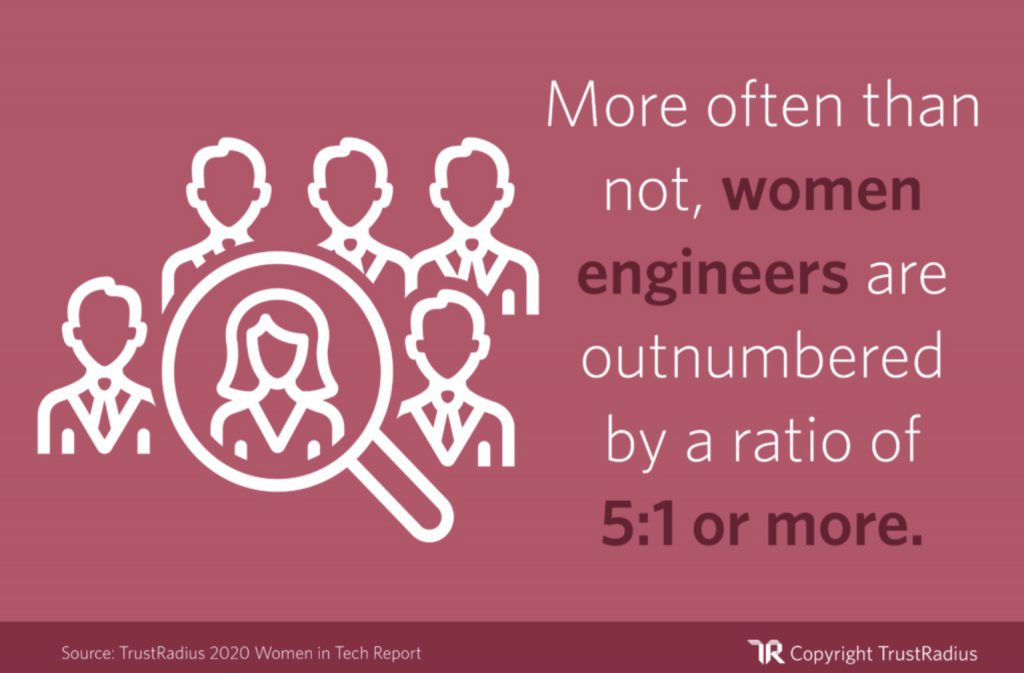
Now, here are the 5 tips for hiring for diversity and inclusion in engineering:
1. Build a tech exclusionary list
Top tech companies have started creating their own internal style guides or setting internal goals to avoid using exclusionary language. For example:
- Amazon engineers have created an internal Wiki page that lists unconsciously biased terms and how to replace them in their everyday language. (source: Business Insider)
- Apple’s new coding terminology reflects its efforts to remove and replace non-inclusive language across Xcode, platform APIs, documentation, and open-source projects. (source: ZDNet)
Typical programming language can sometimes include terms with racist or otherwise offensive connotations. This guide from Northwestern University shares some commonly used offensive terminology in the tech sector so you can more easily avoid it.
Along with revamping your tech language, creating bias-free job descriptions is key to inclusive hiring in tech. Ongig’s Text Analyzer flags biased terms that could make underrepresented groups feel excluded.
Here are 2 examples:
The screenshot below shows a Data Scientist job description using the word “blacklisting” which is considered exclusionary to people of color in tech. Using more inclusive synonyms like the ones listed in the pop-up box removes bias and can help you recruit more diversely.
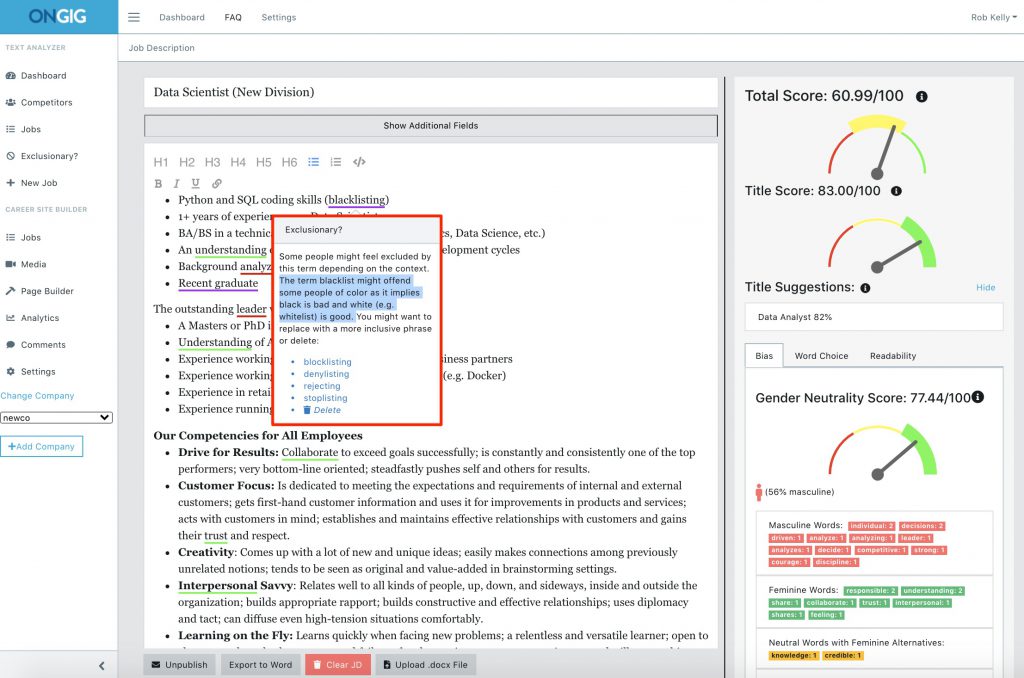
The Chief of Staff job description below shows masculine bias. Words like “competitive” can be replaced with words that do not contain gender bias towards women or women of color in tech.
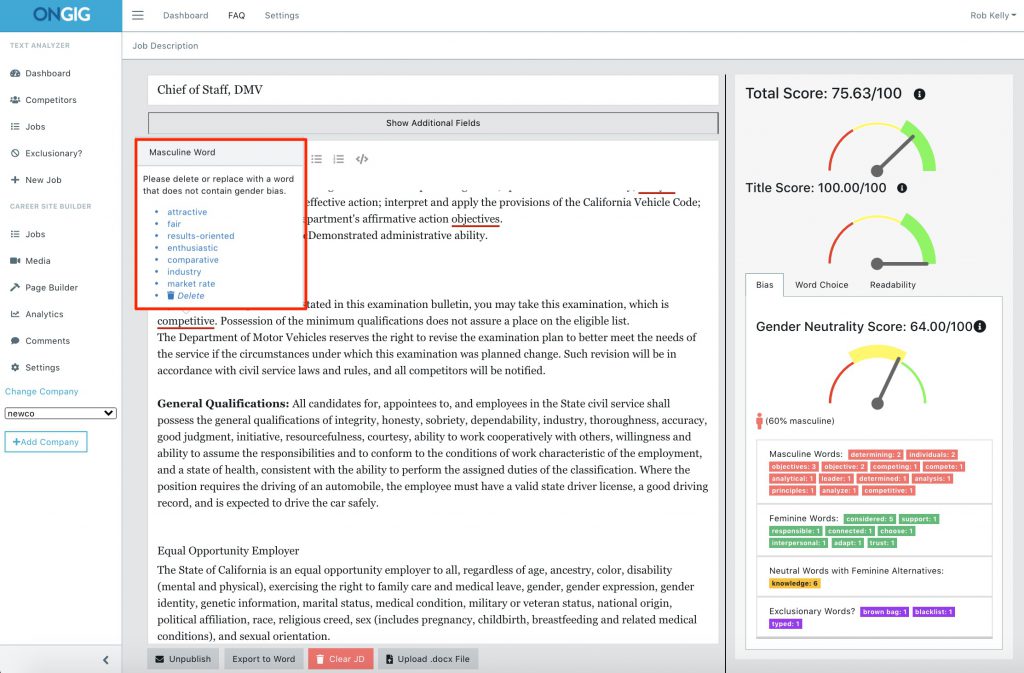
An article by Forbes on Achieving Workplace Diversity Through Recruitment In Tech says:
“It is also crucial to avoid gender-coded words like “guru,” “rockstar,” “aggressive” or “independent,” and look for collaborative team players instead with words like “dedicated,” “sociable” and “conscientious.” There is evidence that women are less attracted to terms that focus on competition as opposed to terms that depict commitment and support. The goal is to remove gender-biased terms in the hopes of increasing the applicant pool.”
Companies regularly modify their job descriptions to include language that supports inclusive hiring. According to Hacker Earth:
“Buffer uses its blog as a medium to explore issues in tech which affect underrepresented groups. The company also regularly modifies its job descriptions to include language and images that support inclusive hiring. They also sponsor awesome initiatives such as POCIT‘s Beer and Boardgames event and #wocintech‘s awesome photos.”
When an industry is already lacking in gender or racial diversity, it’s even more important to use neutral and inclusive language in your job descriptions. Women and people of color already face significant barriers in the engineering field— don’t perpetuate this inequality with poor hiring strategies.
2. Set goals for recruiting diversity in engineering
Set company-wide goals for hiring diversity in engineering, so that your organization has accountability to reach your diversity goals. The companies below have invested dollars and set public goals to hire more underrepresented groups in tech roles:
- Atlassian — lead an initiative to create more balanced technical teams.
- HubbleHQ — committed to actively reduce unconscious bias in their hiring process to bring more diverse people on board.
- Intel — donated $1.32 million to the “Growing the Legacy” scholarship, awarded to 40 Native American STEM students every year, and plans to increase the number of women in technical roles to 40% by 2030.
- Pinterest — committed to expanding their engineering roles to 30% held by women and 8% held by people from underrepresented ethnic groups.
- Siemens — invested more than $115 million in a pipeline of diverse STEM talent through workforce development initiatives.
(Editor’s note: For more company goals beyond diversity and inclusion in tech, check out 25+ Examples of Awesome Diversity Goals.)
How did Etsy recruit more women software engineers?
In 2011 Etsy only had 3 women engineers out of 47. So they invested in training junior women engineers through their Hacker School, in partnership with 37Signals and Yammer.
By 2013, Etsy’s engineering diversity increased by 500%, with an engineering team of 20 women and 90 men, according to FastCompany.
This is a great example of how companies can meet diversity hiring goals with a genuine and material commitment to better hiring.
3. Use blind hiring tools for diversity in engineering
You can also increase diversity in engineering by using blind hiring tools. Companies that use tools that remove the potential for bias throughout the hiring process have a better chance of finding more diverse employees.
Tools like Toggl Hire help companies to create skills-based assessments for candidates. Skills-based hiring can offer candidates who may experience hiring bias, such as neurodiverse individuals, the chance to prove their skills without the pressure of a live interview.
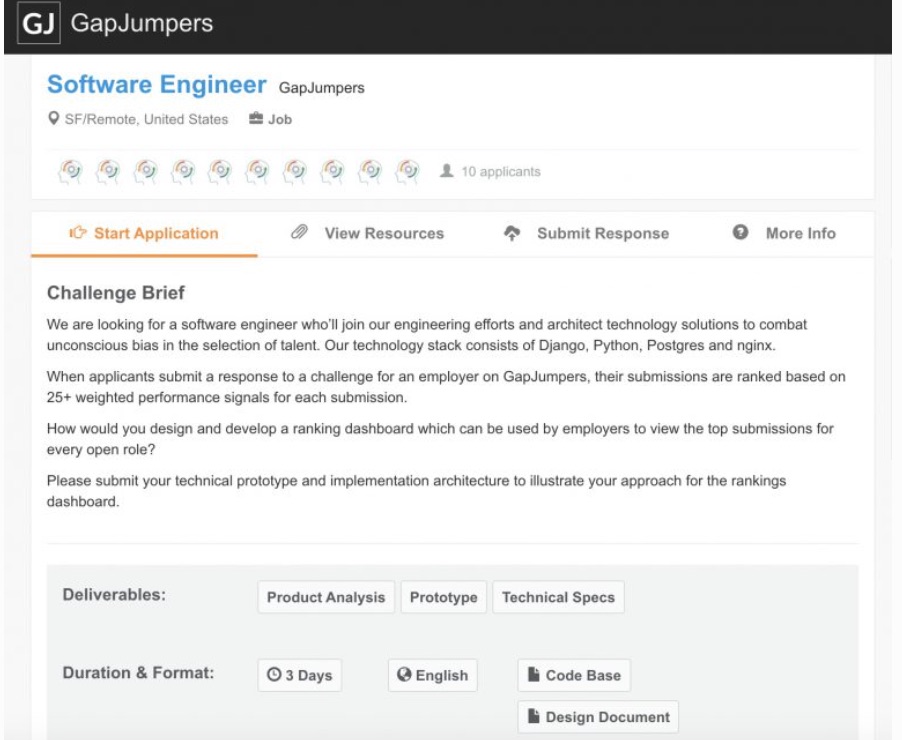
Giving neurodiverse candidates the opportunity to showcase their skills anonymously is often more valuable than an in-person interview. A recent virtual conference on Eliminating Bias from Hiring focused success with increasing neurodiversity in engineering roles by using skills-based hiring. Someone with autism or ADHD may not perform well in interviews but excel in a project designed around “real life” tasks for a job.
Companies like SAP, VMware, and JPMorgan Chase have also created dedicated programs for hiring people with autism, dyslexia, dyscalculia, ADHD, and Tourettes.
Blind hiring tools like Pinpoint Recruitment, Blendoor, and Entelo remove details from a resume that could cause bias towards diverse engineers. Pinpoint Recruitment’s Blind Resume tool makes candidate resumes anonymous. The Pinpoint tool reads applicant data, then presents a redacted resume to the hiring manager. The screenshot below shows “Pink Peas” as an applicant and their personal data is hidden for the candidate screening process.
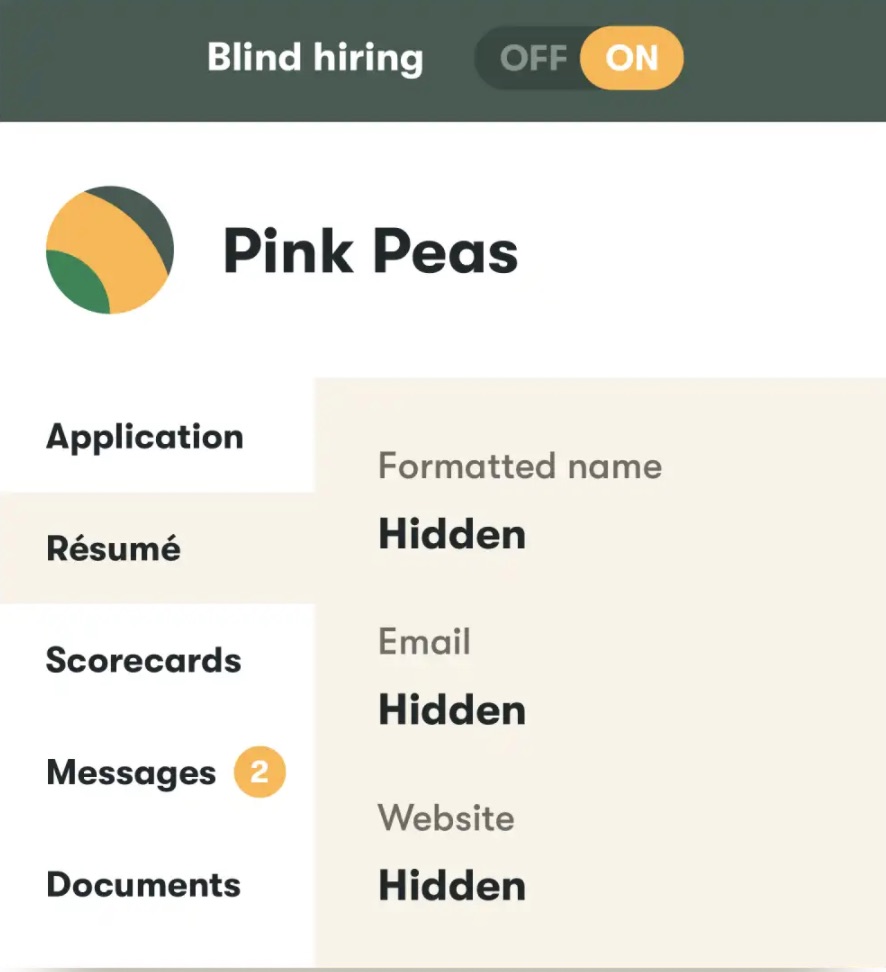
Removing unconscious bias creates more opportunities for hiring diverse candidates in engineering.
4. Recruit from coding camps and programs for diversity in
engineering
Recruiting from coding camps or programs, especially those focused on diversity recruiting in tech is another great idea. One example of a company that has success with this strategy is Slack. According to Hacker Earth:
“Since 2015, the company has proactively sought out candidates from outside traditional developer pipelines such as Stanford and MIT. It has also focused on recruiting tech talent from all women’s coding camps such as Hackbright and programs that focus on training black and Latino programmers such as Code2040.”
AngelList lists 41 Companies That Hire Coding Bootcamp Graduates on their website. A few companies on the list are:
- Greenhouse
- Vimeo
- Mixpanel
- Vroom
- PwC
Outside of coding camps and programs for engineering diversity, there are quite a few diversity recruitment websites that cater to diversity recruiting in tech. Arshiya Malik’s post on Medium lists some companies who are connecting employers to diverse pools of talent. Here are a few directly from Arshiya’s blog:
- SquadProfile: From the CEO of Lesbians Who Tech, Squad is helping companies build their best teams by connecting them to underrepresented tech professionals looking to find their dream job and get hired for who they truly are.
- People of Color in Tech: A top recruitment platform that helps connect people of color with jobs in tech and startups.
- Project Basta: Bridging the college to career gap for first-generation graduates of color.
5. Highlight underrepresented groups on your career page
If you want to know how to find highly qualified diverse candidates in engineering, another idea is to highlight diversity in engineering on your career page.
Elastic’s dynamic career page, pictured below, showcases employee stories in a special section called “Someone Like Me”. One feature is a story from Liza Dayoub on women in open source.
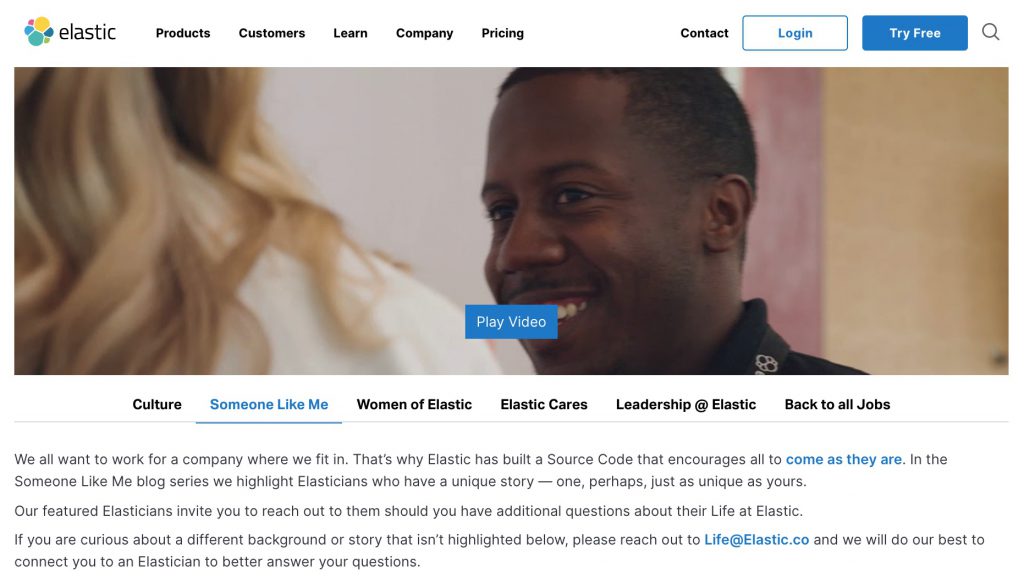

Tools like Ongig’s Career Site Builder make it easy for you to create custom microsites for diversity in the tech industry on your career page.
6. Create mentorship programs for employees
It may seem counterintuitive to devote funds for diverse recruiting to employee retention. But strategies for diverse recruitment fail when they don’t prioritize developing a workplace that is truly welcoming and inclusive. Diverse hiring doesn’t count for much when you can’t retain women, employees of color, disabled employees, and other underrepresented workers.
Invest in a long-term diverse hiring solution by creating mentorship programs for employees. According to Matthew Reeves, CEO of the mentorship platform Together, mentorship addresses deep and pervasive biases within the workplace. In an article for Forbes, he says:
“Mentorship is pivotal in creating inclusive workspaces where every employee, regardless of their background, feels empowered to contribute their best work while being their most authentic selves. So this strategy’s objective goes far beyond professional development. Mentorship in this context is about building a workplace that harnesses diversity as a strength and creating a culture that celebrates differences.”
Once you’ve established a mentorship program for employees, you can mention it in your job descriptions, on your company website, and in other promotional materials for potential candidates.
7. Recruit from HBCUs and other minority-serving institutions
When recruiting new graduates in STEM fields such as engineering, employers have a tendency to over-focus on Ivy league schools, where Black students are underrepresented.
Instead of recruiting exclusively from elite engineering schools like MIT and Stanford, consider tapping the nation’s prestigious historically Black colleges and universities (HBCUs). Many highly-respected HBCUs have great engineering programs. These include programs at schools such as:
Diverse Perspectives: The Importance of Diversity in Engineering
Diverse perspectives are essential for innovation and problem-solving in engineering. When a team includes people from different backgrounds, they bring a variety of different experiences and ideas to the table. Therefore, this diversity of thought is the key to developing innovative solutions that can address complex challenges.
Enhancing Innovation Through Diversity in Engineering
Diverse teams are more likely to come up with creative and innovative solutions because they draw from a wider range of different experiences and viewpoints. For example, when young engineers from different racial minorities, sexual orientations, and different cultures collaborate, they offer insights that a homogenous team might miss. This is also why engineering education programs, including those in the college of engineering and school of engineering, emphasize the importance of diversity in their strategic plans. So, these institutions encourage diverse students to contribute their unique perspectives. Thus, leading to better outcomes.
Problem-Solving with Diverse Teams
When tackling complex problems, having a diverse team of engineers allows for more effective problem-solving. Members of diverse teams approach challenges differently based on their different backgrounds. So, this diversity of thought also leads to more thorough exploration of possible solutions. Ultimately, finding the best way to solve problems. For example, imagine a team that includes first-generation college students, faculty members from underrepresented groups, and professionals with a wide range of personal experiences. They are more likely to identify innovative and effective strategies.
Building Stronger Teams with Diversity
A diverse workforce not only enhances problem-solving and innovation. But it also strengthens overall team performance. Therefore, an inclusive environment where diverse backgrounds are valued fosters collaboration and personal growth. So, team members get to learn from each other’s different experiences. And this also helps them develop stronger leadership skills and better understand the needs of the general population.
The Broader Impact of Diverse Perspectives
Diversity in the engineering community also has a positive impact on society as a whole. When racial minorities and other underrepresented groups need to see representation of women and diverse talent in leadership positions. It inspires young people to pursue careers in engineering. Also, this increased representation of women, gender identity, and racial minorities helps to address the root causes of social justice issues and promotes equal opportunity for all.
Creating an Inclusive Culture
To fully realize the benefits of diverse perspectives, it’s important to build an inclusive culture within the engineering profession. Inclusive hiring practices and best practices for recruiting and retaining qualified individuals from diverse backgrounds are crucial. This shared responsibility should be embraced by everyone, from tenure-track faculty to staff members and student organizations. In effect, the engineering profession can create a welcoming environment that reflects the diversity of ideas and experiences within the general population.
There has been a growing recognition of the importance of diversity in engineering. So, by continuing to prioritize diversity and inclusion, the engineering community can build a better, more innovative future for all.
WHY I WROTE THIS
Ongig supports recruiting diversity in the tech industry. If you want to learn more about creating a dedicated diversity in tech page on your career site or analyze your job descriptions for bias request a demo to learn more.
Shout-Outs:
- Five Years of Tech Diversity Reports—and Little Progress (by Sara Harrison)
- Someone Like Me (by Elastic)
- The state of ethnic minorities in U.S. tech: 2020 (by Galen Gruman)
- 2020 Women in Tech Report (by TrustRadius)
- 14 Companies With Standout – And Effective – Diversity Recruiting Strategies (by Danielle Agugliaro)
- Diversity in Tech: HubbleHQ’s Engineering Team Is Now 50% Female (by Hannah Watkins)
- How Etsy Attracted 500 Percent More Female Engineers (by Anna Kamenetz)
- The Go-Getter’s guide to diversity hiring in tech (by Soumya Chittigala)
- Achieving Workplace Diversity Through Recruitment In Tech (by Elaine Montilla)
- These 21 Companies are Connecting Employers to Diverse Pools of Talent (by Arshiya Malik)
- 41 Companies That Hire Coding Bootcamp Graduates (by AngelList)
- How Tech Companies are Paving the Way for Diversity in Engineering (by Arkady Zapesotsky)
- Amazon engineers built an internal wiki page that suggests alternatives to unconsciously racist terms like ‘brown bags,’ ‘cake walk,’ and ‘master/slave’
- Apple’s new style guide replaces non-inclusive language
- Engineers and Autism (by IEEE Spectrum)
